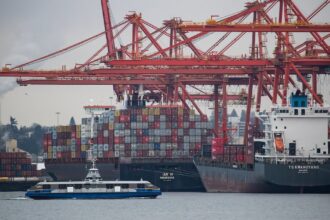In a watershed moment for Canadian economic integration, Finance Minister Chrystia Freeland announced yesterday a comprehensive federal initiative to dismantle longstanding interprovincial trade barriers that have fragmented the national economy for decades. The ambitious plan, unveiled during a press conference in Ottawa, aims to create what Freeland described as a “truly borderless internal market” that could potentially add billions to Canada’s GDP.
“For too long, we’ve operated as a collection of economic fiefdoms rather than a unified economic powerhouse,” Freeland stated, flanked by representatives from provincial chambers of commerce. “These internal barriers cost our economy an estimated $130 billion annually—that’s nearly 7% of our GDP that simply evaporates due to regulatory differences and provincial protectionism.”
The initiative targets particularly problematic areas that have historically impeded cross-provincial commerce, including professional certification recognition, transportation regulations, and provincial procurement practices. Under the new framework, professional credentials obtained in one province would receive automatic recognition across all provinces, eliminating the need for costly and time-consuming recertification processes.
Industry leaders have responded with cautious optimism. Jasmine Lee, CEO of the Canadian Federation of Independent Business, called the announcement “potentially transformative” while emphasizing the need for provincial buy-in. “We’ve seen federal governments make similar promises before, only to face provincial resistance. The devil will be in the implementation details,” Lee noted in a statement to CO24 Business.
Indeed, previous attempts to address internal trade barriers have yielded limited results. The Agreement on Internal Trade (1995), later replaced by the Canadian Free Trade Agreement (2017), both faced challenges in achieving their full potential due to extensive provincial exceptions and uneven implementation.
The Council of the Federation, representing Canada’s premiers, issued a measured response, acknowledging the economic benefits while asserting provincial jurisdiction. “While we support economic integration that benefits all Canadians, constitutional authority over many areas remains with the provinces,” the statement read. “Any federal framework must respect this reality.”
Economic analyses suggest the benefits could be substantial. A recent study by the C.D. Howe Institute estimates that removing internal trade barriers could increase per-capita GDP by up to $2,000 annually and potentially create over 120,000 new jobs across the country.
The plan will unfold in three phases over the next four years, beginning with immediate federal regulatory changes, followed by incentivized provincial harmonization efforts, and culminating in a new national standards framework. The federal government has allocated $3.7 billion to support transition costs and compensate for potential short-term economic displacements.
Small business owners across Canada stand to benefit significantly. Michael Torres, who operates a specialty food manufacturing business in Quebec, expressed frustration with the current system: “I can sell my products more easily to customers in France than to someone in neighboring Ontario because of different provincial regulations. This reform can’t come soon enough.”
Labour mobility represents another critical dimension of the initiative. Currently, approximately 20% of Canadians live in provinces different from where they were born, a surprisingly low figure compared to internal migration rates in other federal countries. Enhanced labour mobility could help address regional skill shortages while providing workers with expanded opportunities.
The success of this ambitious national project ultimately hinges on an elusive commodity in Canadian federalism: sustained intergovernmental cooperation. As Canada navigates post-pandemic economic recovery challenges, the question remains: will provincial governments embrace a truly national economic vision, or will regional interests once again prevail over collective prosperity?














